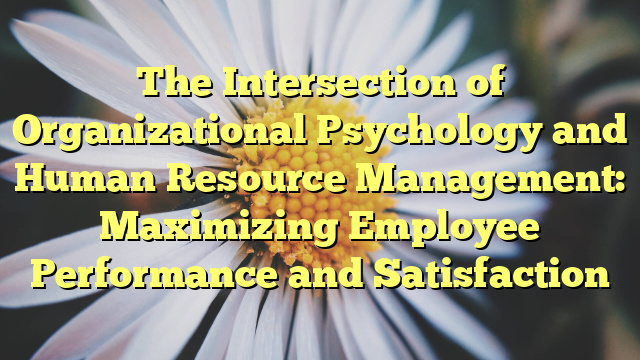The Intersection of Organizational Psychology and Human Resource Management: Maximizing Employee Performance and Satisfaction
The Intersection of Organizational Psychology and Human Resource Management: Maximizing Employee Performance and Satisfaction
Introduction
Organizational psychology and human resource management are two fields that are closely intertwined and have a significant impact on employee performance and satisfaction. By understanding the intersection of these two disciplines, organizations can create a work environment that maximizes employee potential and fosters a sense of fulfillment and well-being.
The Role of Organizational Psychology
Organizational psychology, also known as industrial-organizational psychology, focuses on understanding human behavior in the workplace and applying psychological principles to improve organizational effectiveness. This field encompasses various areas such as employee motivation, job satisfaction, leadership, and team dynamics.
One of the key contributions of organizational psychology to human resource management is its emphasis on understanding individual differences and tailoring management practices accordingly. By recognizing that employees have unique needs, strengths, and preferences, organizations can design job roles, performance evaluations, and training programs that align with individual capabilities and aspirations.
The Role of Human Resource Management
Human resource management (HRM) is responsible for managing the human capital within an organization. It involves activities such as recruitment, selection, training, performance management, and employee relations. HRM plays a crucial role in creating a positive work environment and ensuring that employees are engaged, motivated, and satisfied.
HRM practices are heavily influenced by organizational psychology principles. For example, the recruitment and selection process can be enhanced by using psychological assessments and interviews to identify candidates who possess the necessary skills and fit the organizational culture. Similarly, performance management systems can be designed to align with psychological theories of motivation and goal-setting, thereby maximizing employee performance.
The Intersection: Maximizing Employee Performance
When organizational psychology and HRM intersect, organizations can develop strategies to maximize employee performance. One such strategy is the implementation of performance feedback and coaching programs. By providing employees with regular feedback and coaching sessions, organizations can help them identify their strengths and areas for improvement, set meaningful goals, and develop action plans to enhance their performance.
Another area where the intersection of organizational psychology and HRM is evident is in the design of training and development programs. Organizational psychology principles can be used to identify the most effective training methods, such as experiential learning or simulations, based on individual learning styles and preferences. HRM can then implement these programs to enhance employee skills and knowledge, leading to improved performance.
The Intersection: Maximizing Employee Satisfaction
Employee satisfaction is a critical factor in organizational success, as satisfied employees are more likely to be engaged, productive, and committed to their work. The intersection of organizational psychology and HRM offers several strategies to maximize employee satisfaction.
One such strategy is the implementation of flexible work arrangements. Organizational psychology research has shown that employees who have control over their work schedules and locations experience higher levels of job satisfaction. HRM can facilitate flexible work arrangements, such as telecommuting or flexible hours, to accommodate employees’ personal needs and preferences.
Another strategy is the promotion of work-life balance. Organizational psychology emphasizes the importance of balancing work demands with personal and family responsibilities. HRM can implement policies and programs that support work-life balance, such as offering parental leave, flexible vacation policies, and wellness programs. These initiatives contribute to employee satisfaction and overall well-being.
The Benefits of the Intersection
The intersection of organizational psychology and HRM offers numerous benefits for organizations and employees alike. By incorporating psychological principles into HRM practices, organizations can create a work environment that fosters employee engagement, motivation, and satisfaction. This, in turn, leads to improved performance, productivity, and retention.
Employees also benefit from this intersection as they are provided with opportunities for personal and professional growth. By aligning job roles, training programs, and performance evaluations with individual strengths and aspirations, employees feel valued and supported in their career development.
Conclusion
The intersection of organizational psychology and HRM is a powerful combination that can significantly impact employee performance and satisfaction. By understanding and applying psychological principles in HRM practices, organizations can create a work environment that maximizes employee potential and fosters a sense of fulfillment and well-being. This ultimately leads to improved organizational effectiveness and success.

